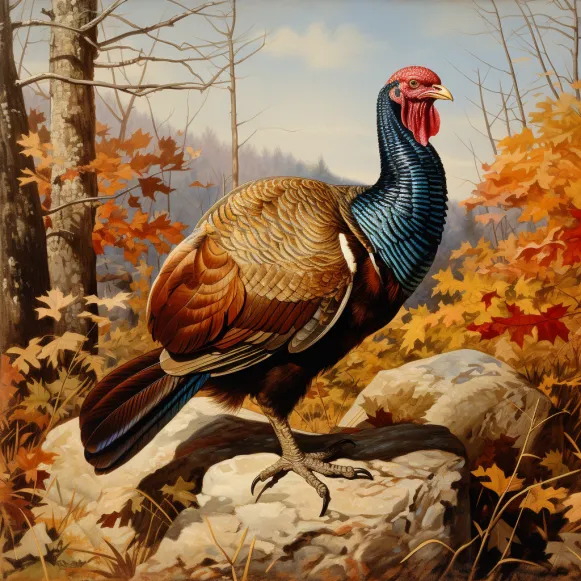How did Minnesota become the nation’s top turkey state?

1 in 5 turkeys grown commercially in America are from Minnesota
Minnesota is a turkey superpower.
Since the late 1950s, Minnesota has been a national leader in the production of this flightless bird, ranking first among states for the last two decades. Minnesota now produces one in every five commercially grown turkeys in America, with the state producing approximately 37 million birds last year.
So, if you’re a traditionalist, the turkey on your plate this Thanksgiving was probably raised on one of Minnesota’s more than 650 turkey farms. This year, two special birds from Jennie-O in Willmar will even be granted official Thanksgiving pardons at the White House.
Wild turkeys are so common in Minnesota these days that they occasionally clog city streets. However, Minnesota is not an ideal location for raising the nation’s dinner bird.
Poults (baby turkeys) prefer temperatures in the 90s. Furthermore, because Mississippi is located on the Mississippi Flyway, one of the continent’s bird superhighways, commercial flocks can be exposed to diseases from wild birds, often through contaminated feed, equipment, or even farmer clothing.
So, how did Minnesota become the leading producer of turkeys? Curious Minnesota, the Star Tribune’s reporting project fueled by reader questions, received a letter from reader Randy LaFoy asking why Minnesota produces so many turkeys each year.
The state’s access to abundant grain in the breadbasket of the United States aided the success of the turkey industry. However, turkey farming became popular in part due to the efforts of a culinary-minded University of Minnesota Extension veterinarian named William “Doc” Billings and some intrepid farm wives who assisted in the eradication of a disease that had previously limited the size of turkey flocks.
Solving a turkey dilemma
Minnesota’s turkey industry was in shambles a century ago.
Birds continued to perish. Blackhead, a nasty liver inflammation, killed up to 75% of turkey flocks raised outdoors, often alongside chickens. And the farm women, who usually raised the birds for extra money, were at their wits’ end with the gobblers.
The bird business was small, and no one knew how to raise birds in captivity.
“The whole field of turkey husbandry is crowded with superstitious beliefs about turkeys,” Billings wrote in a 1929 Minneapolis Tribune article about the animals, which were described as a “stately and toothsome bird of the pheasant family.”
Farmers were speculating on everything from egg incubation to bird feeding. According to the Tribune, many farmers believed domesticated turkeys should forage for themselves on the farm.
“Garbage may be all right for hogs, but it won’t raise turkeys,” Billings said in a statement.
Fortunately, Minnesota farmers had an advantage: the University of Minnesota Extension, which disseminated the best ideas from the state’s public university to its farmers.
Cora Cooke, an Ivy League-trained poultry expert who was hired by the University’s Extension in 1921 to travel the state helping farm wives with turkey tips, led the poultry outreach efforts. According to a 1999 history of the U’s ag outreach agency authored by former Extension director Roland Abraham, Cooke’s initial message to the women was to practice “culling” — slaughtering hens that didn’t lay enough eggs — to improve the flock’s overall breeding capability.
This method assisted in increasing the number of birds. However, the blackhead disease is still spreading among flocks. Billings, the veterinarian, would provide the solution.
Billings was aware that at the turn of the century, a researcher at Rhode Island University discovered that blackhead disease — histomoniasis — was commonly spread in mixed flocks. While chickens were mostly immune, the disease killed turkeys.
According to Abraham’s history, the Rhode Island research had “languished” on the shelf. Billings, on the other hand, dusted it off and persuaded a few farms in western Minnesota to separate the chickens and turkeys.
The transformation was almost instantaneous. The miraculous cure in husbandry quickly spread. Billings had some other ideas as well.
First, he urged the growers to incubate the birds artificially. He then advised keeping the birds in a confined space while they pondered. The Minnesota bird industry expanded rapidly.
Minnesota farmers reported 450,000 animals under “other poultry” in the 1920 Agricultural Census. According to US Department of Agriculture records, the state had 1.4 million commercial birds by 1929. After a decade, the North Star state had raised just under 3 million turkeys.
How turkeys became big business
Raising turkeys was now a profitable way to diversify a grain farm, thanks to new husbandry advice disseminated by Extension and other farmers.
Earl B. Olson started raising turkeys on his farm in western Minnesota in 1940. By the end of the decade, he had purchased a processing plant in Willmar. That plant would be named Jennifer after his daughter.
Soon after, Jennie-O became a national leader in turkey production.
“The success of Earl B. Olson brought a lot of competition,” said Steve Lykken, president of Jennie-O Turkey Store, an Austin-based Hormel subsidiary. “It wasn’t just turkeys he was selling here. He was transporting turkeys to Chicago’s meatpacking district.”
To boost farmer morale during a difficult year, Lykken said, the turkey godfather would drive a brand new Cadillac around the countryside to show farmers what they could achieve with a little determination.
“I think ‘contagion’ is the right word to describe his success,” he said.
Minnesota first ranked first in turkey production in 1959, then again from 1968 to 1980. North Carolina was the state’s closest competitor from the 1980s until Minnesota overtook it in the twenty-first century.
Willmar is the center of the turkey industry in Minnesota. Select Genetics, the nation’s largest turkey hatchery, is headquartered there. It also serves as the corporate headquarters for Jennie-O, which employs over 5,000 people and distributes turkey products in over 40 countries.
Today’s turkey production system is highly controlled from farm to processor, a concept known as vertical integration. The majority of birds raised in Minnesota are slaughtered by Jennie-O, Northern Pride in Thief River Falls, or Turkey Valley Farms in Marshall.
The free-range-raising Ferndale Market out of Cannon Falls is also a popular option, especially in Twin Cities cooperatives and grocery stores.
In keeping with its historical roots, the industry has a number of women at the forefront, particularly after navigating the last couple years of avian influenza.
When Ashley Kohls became president of the Minnesota Turkey Growers Association last year, she was impressed by the significant roles women held in the industry.
“All the prominent [turkey veterinarians] are women, as well,” Kohls told me.
Reinventing stuffing
When Billings retired in 1956, he shifted his focus from turkey health to an even more contentious Thanksgiving debate: the debate over the proper “stuffing.”
Even in the capable hands of a chef, Billings believes that stuffing, the holiday staple cooked inside the bird, is too often a “dark, sticky, soggy mess that lays like a ton of bricks in your stomach.” He blamed cooks for putting “everything but the kitchen sink” into the cavity of the bird.
Instead, Billings endorsed his own dressing, which he first prepared in a pan, as the ideal dinner-table companion to the turkey. He even invited the public to contact St. Paul’s University Farm for his own simple recipe.
What are the ingredients? Cubed white bread, chopped onion, butter, salt and sage to taste.






